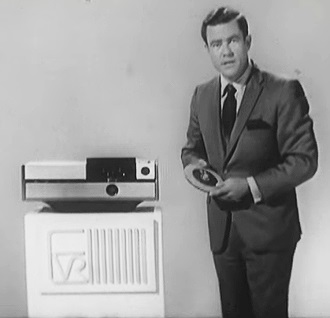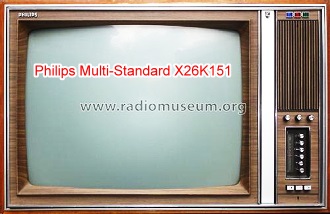Looking Ahead: Electronic Video Recording | Color TV |
|
In the pre-VHS era, companies were vying to create and set standards for the home-based video recording and playback industry. The same sort of scenario played out over color television standards a decade earlier, and over B&W television a couple decades before that. Such battles for dominance in emerging technologies were not new, and continue into the current time. Various schemes for Electronic Video Recording (EVR) systems were being used by commercial media, but creating devices affordable to Harry and Harriet Homeowner (who live next door to Joe and Jane Sixpack) was a challenge. Betamax, produced by Sony, hit the store shelves in 1975, then VHS (Video Home System) a year later. A sort of 8-track vs. compact cassette battle ensued, but VHS clearly emerged as the winner - followed by DVD (1996) and Blu-ray Disc (BD - 2006). Also reported was the world's most expensive - and feature-filled - color TV, built by Philips, that was "more computer than television," being able to operate on eleven different modulation standards. Looking Ahead: Electronic Video Recording | Color TV
Columbia Broadcasting System Electronic Video Recording (EVR) Philips Multi-Standard X26K151 Color Television (Radio Museum) EVR - What It Means With fanfare befitting a television network, the Columbia Broadcasting System has officially launched its Electronic Video Recording (EVR) and duly forecast that its impact on education and home entertainment will be revolutionary. The ingenious system, developed by a team under CBS Laboratories President Dr. Peter Goldmark, who 20 years ago gave the world the long-playing record, is described as the sight-and-sound equivalent of the LP disc. Using film in an unconventional manner, it's a playback-only medium which may give the proposed home video tape systems a run for their money. EVR players for educational and industrial use will be produced first, to be made exclusively by Motorola Inc. in the U.S. and Canada until 1971, after which CBS hopes the home market will be ripe and other manufacturers will be licensed to make the players. Judgment of EVR's impact on the home will have to wait until CBS drops the other shoe, for the system's most intriguing aspect - the generation of color pictures from a low-cost black-and-white film cartridge - is still in the lab and the consumer version isn't expected to be ready until 1971. What has been demonstrated, and what Motorola will produce first, is a black-and-white player that combines the simplicity of notion picture film with the handling ease and flexibility of a tape cartridge system. The player feeds directly to the antenna terminals of any standard television set by means of a single cable. The film is contained in a completely enclosed circular cartridge 7 inches in diameter and less than 3/8-inch thick, with a large center hole, looking like a swollen 45-rpm disc. The film itself is completely unorthodox. Measuring just 8 mm, it has no sprocket holes and contains two series of frames side by side, each with its own magnetic sound track, providing in effect, two "tracks" of visual material (photo). In the center, between the pictures, is a series of white indexing indicators, which trigger the player's electronic "shutter" while the film moves continuously at 6 ips. Each track will play up to 26 minutes for a total of 52 minutes, with 180,000 individual frames. To play an EVR film, the cartridge is dropped on the spindle of what looks like a 45-rpm phonograph (an automatic tape-cartridge changer is within the realm of possibility). The play button is pressed and the film is automatically threaded onto a take-up reel like a tape recorder, the EVR player is capstan-driven and has fast- forward and reverse pushbuttons, a digital frame counter, plus additional pushbutton controls to stop the motion (providing a still picture) and for selecting track A or track B. As viewed in CBS's demonstration, using Motorola 18-inch TV sets as monitors, the system provided extremely high-resolution pictures with excellent contrast - superior to all but the best off-the-air reception - particularly remarkable in view of the fact that each actual film frame is only 3-mm wide. Although CBS has revealed few technical details, it's known that the player uses a flying-spot scanner as the pickup agent. Motorola plans to introduce its first black-and-white EVR players early in 1970, designed for specialized non-home markets. These ruggedized units will be priced at "less than $800," but still considerably above the $280 estimated by CBS more than a year ago. The New York Times will be the first organization to produce films for EVR. These will be a series of 50 educational selections for use in schools, each running 15 to 20 minutes. What's in it for CBS? The processing bonanza. The network company is now building a plant to make EVR cartridge films from standard 16 and 35 mm film and video tape. Cartridges, says CBS, can be duplicated at extremely high speed and relatively low cost. Informal estimates were $7-$8 for processing and "cartridging" the film, with a resulting price of $25-$35 per complete educational film package. No significant in-home market is envisioned until the color version becomes available. The color EVR will use the same size cartridge, operating at the same speed, but giving only one-half the playing time - a maximum of 26 minutes, or about 30 minutes if thinner film is used. The space occupied by Track B on the current black-and-white film will be devoted to coded information which, electronically scanned, will "color" the optical image on Track A. A demonstration of the principle of color EVR is expected soon (perhaps including a "sneak preview" on one of CBS's television stations), when CBS introduces a similar system, but in 16-mm size and without the cartridge, for use by television stations to produce color pictures electronically from specially processed black-and-white film. It's claimed to give resolution equal to that of 35-mm color film. Whether EVR will ever be a significant consumer product will be known only after the introduction of the home color version in 1971, and when the prices of home players (or combination color sets and EVR) are established. World's Most Sophisticated Color TV What must be the world's most complicated home television receiver is now on sale in Belgium, which obviously is the most confusing place in the world for a TV viewer to live. In much of the country, broadcasts can be received on non-standard Belgian 625- and 819-line systems as well as from the Netherlands, Germany, France and Luxembourg in various other standards, in two color systems and on two broadcast bands. More computer than TV receiver, the color set built by Philips has an automatic switching system which adjusts it to receive at programs in at least 11 different combinations of standards and frequency bands. In case you're interested, these are some of the combinations: European 625-line b-w and PAL color on vhf and uhf, Belgian 625-line b-w (whose picture and sound modulation differ from general European standard) in vhf and an eventual second channel in uhf, the same Belgian system with PAL color and with SECAM color (not yet on air), Belgian 819-line b-w on vhf, French 819-line b-w vhf broadcasts (with channel width and spacing different from the Belgian equivalent), French 625-line broadcasts in SECAM color on uhf. The price, for a table model: more than $1,000.
Posted March 24, 2023 |
|


